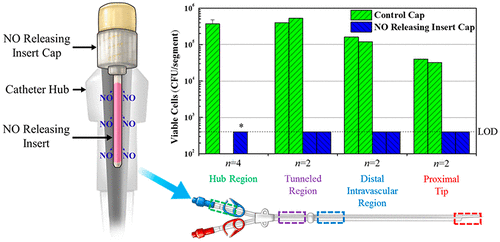当前位置:
X-MOL 学术
›
ACS Appl. Mater. Interfaces
›
论文详情
Our official English website, www.x-mol.net, welcomes your
feedback! (Note: you will need to create a separate account there.)
Hub Region Disinfecting Nitric Oxide Releasing Insert for Tunnel Dialysis Catheters.
ACS Applied Materials & Interfaces ( IF 8.3 ) Pub Date : 2020-09-15 , DOI: 10.1021/acsami.0c13230 Joshua C Doverspike 1 , Shale J Mack 1 , Amy Luo 1 , Blake Stringer 1 , Shelby Reno 2 , Marie S Cornell 2 , Alvaro Rojas-Pena 2, 3 , Jianfeng Wu 4 , Chuanwu Xi 4 , Alexander Yevzlin 5 , Mark E Meyerhoff 1
ACS Applied Materials & Interfaces ( IF 8.3 ) Pub Date : 2020-09-15 , DOI: 10.1021/acsami.0c13230 Joshua C Doverspike 1 , Shale J Mack 1 , Amy Luo 1 , Blake Stringer 1 , Shelby Reno 2 , Marie S Cornell 2 , Alvaro Rojas-Pena 2, 3 , Jianfeng Wu 4 , Chuanwu Xi 4 , Alexander Yevzlin 5 , Mark E Meyerhoff 1
Affiliation

|
The use of tunneled dialysis catheters (TDCs) for patients in need of hemodialysis treatments (HDs) causes a significant number of bloodstream infections (BSIs), with very few viable preventative/treatment methods. Use of antibiotics is relatively ineffective due to the development of multidrug-resistant bacterial strains and the inability to penetrate bacterial biofilms. Nitric oxide (NO) is an endogenous gas molecule that has broad-spectrum antimicrobial/antibiofilm activity. In this study, the potential of creating a NO-releasing insert device that is attached onto the hub region cap of TDCs and locally releases NO within the TDC hub is evaluated for its antimicrobial/antibiofilm effectiveness. The NO-releasing insert contains the natural NO donor S-nitrosoglutathione (GSNO), along with zinc oxide (ZnO) nanoparticles to accelerate NO release from the GSNO, within a short silicone tube that is sealed at both ends and attached to the catheter cap. An in vitro 3-d-long antimicrobial study using catheter hubs yielded >6.6 log reductions of both Pseudomonas aeruginosa and Staphylococcus aureus for the NO-releasing insert device compared to controls. Two 14-d-long sheep studies demonstrated that the NO-releasing insert devices are exceptionally potent at preventing bacteria/biofilm growth on the inner lumen walls of TDCs compared to controls that have no preventative treatment devices as well as implanted TDCs that have commercially available chlorhexidine-treated insert devices placed within the hub regions.
中文翻译:

用于隧道透析导管的中心区消毒一氧化氮释放插入物。
对需要血液透析治疗 (HD) 的患者使用隧道式透析导管 (TDC) 会导致大量血流感染 (BSI),而可行的预防/治疗方法却很少。由于多药耐药菌株的发展和无法穿透细菌生物膜,抗生素的使用相对无效。一氧化氮 (NO) 是一种内源性气体分子,具有广谱抗菌/抗生物膜活性。在这项研究中,评估了创建 NO 释放插入装置的潜力,该装置连接到 TDC 的轮毂区域帽并在 TDC 轮毂内局部释放 NO,以评估其抗菌/抗生物膜有效性。NO 释放插入物包含天然 NO 供体S- 亚硝基谷胱甘肽 (GSNO) 以及氧化锌 (ZnO) 纳米粒子,以加速从 GSNO 释放 NO,在两端密封并连接到导管盖的短硅胶管中。的体外3- d长的抗微生物研究使用产生导管毂>两者的6.6对数减少铜绿假单胞菌和金黄色葡萄球菌的释放NO的插入装置与对照组相比。两项长达 14 天的绵羊研究表明,与没有预防性治疗装置以及已上市的植入 TDC 的对照相比,释放 NO 的插入装置在防止 TDC 内腔壁上的细菌/生物膜生长方面非常有效氯己定处理的插入装置放置在轮毂区域内。
更新日期:2020-10-07
中文翻译:

用于隧道透析导管的中心区消毒一氧化氮释放插入物。
对需要血液透析治疗 (HD) 的患者使用隧道式透析导管 (TDC) 会导致大量血流感染 (BSI),而可行的预防/治疗方法却很少。由于多药耐药菌株的发展和无法穿透细菌生物膜,抗生素的使用相对无效。一氧化氮 (NO) 是一种内源性气体分子,具有广谱抗菌/抗生物膜活性。在这项研究中,评估了创建 NO 释放插入装置的潜力,该装置连接到 TDC 的轮毂区域帽并在 TDC 轮毂内局部释放 NO,以评估其抗菌/抗生物膜有效性。NO 释放插入物包含天然 NO 供体S- 亚硝基谷胱甘肽 (GSNO) 以及氧化锌 (ZnO) 纳米粒子,以加速从 GSNO 释放 NO,在两端密封并连接到导管盖的短硅胶管中。的体外3- d长的抗微生物研究使用产生导管毂>两者的6.6对数减少铜绿假单胞菌和金黄色葡萄球菌的释放NO的插入装置与对照组相比。两项长达 14 天的绵羊研究表明,与没有预防性治疗装置以及已上市的植入 TDC 的对照相比,释放 NO 的插入装置在防止 TDC 内腔壁上的细菌/生物膜生长方面非常有效氯己定处理的插入装置放置在轮毂区域内。











































 京公网安备 11010802027423号
京公网安备 11010802027423号